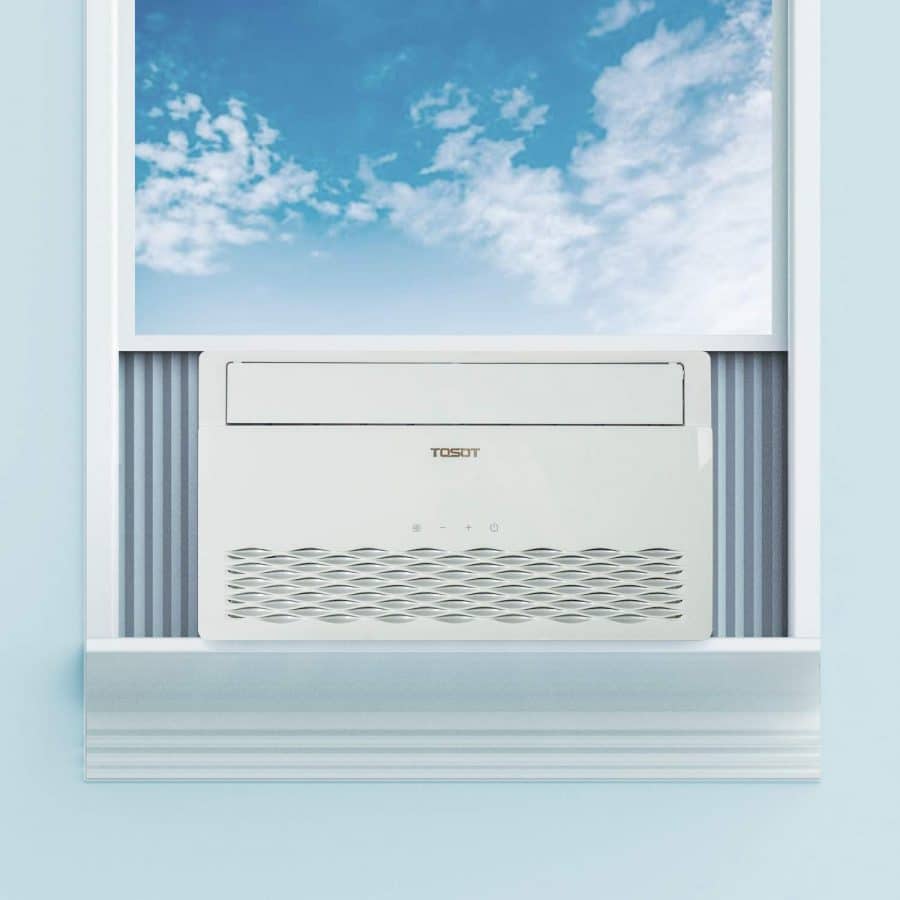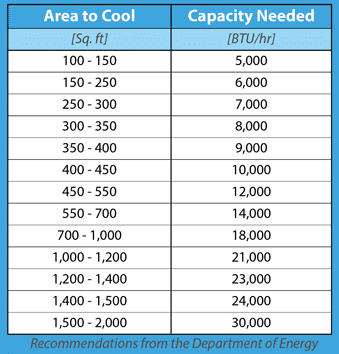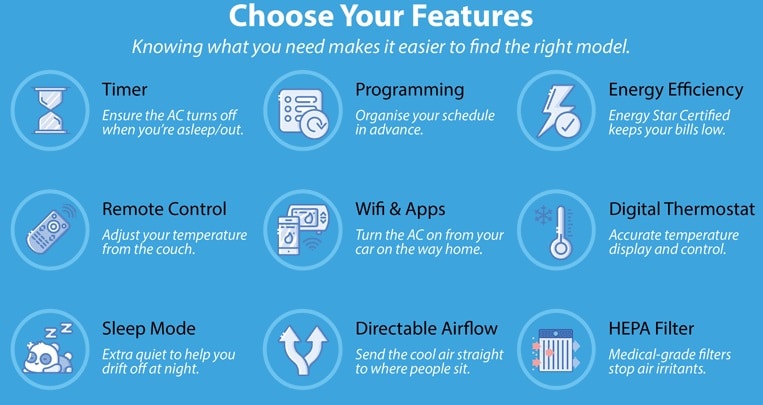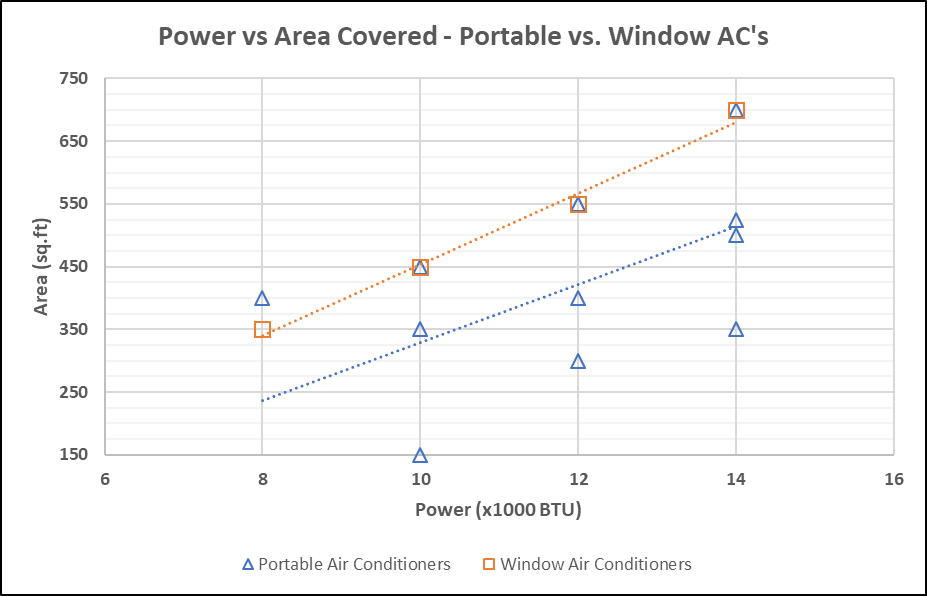We've independently reviewed this article to make sure it's as accurate as we can make it.
To find out more about our article creation and review process, check out our editorial guidelines.
Getting the right size of air conditioner is super important. But it can be intimidating, too.
Getting too powerful of an AC can add up to higher running costs and uncomfortably dry air. Getting too small of a window unit can mean that it deteriorates quickly because it can’t keep up with the heat. Just like Goldilocks, we all want to find the window air conditioner that’s juuust right.
Below I’ve put together a guide and calculator to help you work out exactly the power you need from a window AC.
The size and power of your window air conditioner should be based on the size of your room, ceiling height, amount of sunlight, people in room, and so on. You can quickly get the right window AC size and power with this guide and calculator below.
Below is our visual guide to help, and afterwards is our free window ac size calculator. If you’re stuck on how to use it, read on for a full explanation.

Be sure to check out our guide on how much it costs to run a window air conditioner too (also with a free calculator!).
Don’t have a pen and paper handy? No problem. I’ve put together a calculator that will do all the hard work for you.
Just input your factors and it’ll give you an idea of the BTU you need.
I hope that’s helped give you an idea of what size window AC to look for.
Still not confident? Don’t worry. There’s a full guide and other sections below.
Use the Table of Contents to skip ahead, or read on and we’ll walk through it together.
Looking for a quiet window air conditioner? Our guide covers the quietest models available.
Step by Step: Sizing A Window Air Conditioner
You might be wondering why is sizing important. Well, following this guide will save you money.
‘How? At the end of the day I’m still going to buy a window air conditioner!’ True – but the initial price you pay isn’t what I mean. It’s in your energy bills.
It’s obvious that too small of an air conditioner will cost you more money. It’ll be sucking up all your electricity as it struggles to run on maximum all day long. Not to mention the constant WHIRRR you’d need to put up with!
But did you know that too large of an air conditioner will also increase your bills?
Granted, a large air conditioner will be on economy mode a lot. But the issue is that it’s always switching on and off. Quickly on, then cooling so quickly that it switches back off again. This on/off cycle is what uses a ton of energy to start up the whole system.
Air conditioners are made to maintain a low temperature, and cost the most when they first switch on. So too large of an air conditioner will cost more to run.
Not to mention the extra wear and tear on the compressor from always switching on and off. And the CLUNK noise that happens every time!
Lastly, a large model can cool too quickly. So fast that the dehumidifier function doesn’t run long enough, and we’re left feeling cold but humid. Which is extra uncomfortable.

This is why, it’s important to size a window air conditioner correctly. Thankfully, doing so is very simple.
Just follow these simple sections to find a power level tailored to your home.
#1 Find Your Baseline Area
Just like in the infographic, our first step is to figure out the baseline level of BTU your space needs. This is simply based on the area of the room you’ll put the air conditioner in.
To find the area, just multiply the length x width of a square or rectangular room. If it’s triangular with a right-angled corner, then half that first number – since a triangle is simply half of a rectangle.
If it’s more complex than that, you’ll need to take some initiative! Split the room up into smaller sections and work each out separately. Then add them all together. There’s a small diagram on the infographic which should give you a good starting point.
Remember: This doesn’t need to be exact! We’re just finding a baseline to start with.
#2 Find your Baseline BTU
Once we have an area to work with, it’s simple to get an equivalent size or power of air conditioner.
Simply compare to the table below. For a good sanity check, multiply your area in sq. ft. by 25 – this also gives a rough idea of the amount of BTU we need.

#3 Account for Factors
Now that we have the basic power requirement, it’s time to match it to your space.
For each of the following statements that apply, you should add the equivalent factor.

That’s about all there is to it!
Simple, right?
With your final number, look back at that initial chart comparing areas and BTU above. If you’re stuck in the middle of two categories, I’d recommend going slightly stronger.
#4 Decide on Your Features
We’re so fortunate with appliances today. We can choose from older and cheaper models which can still work fantastically well (if you buy the good ones). At the same time, there are also modern models with amazing, time-saving features.
Here’s some of the most popular features – with a bit more detail than in the infographic above.
Note down which of these would make your life easier. Then you can check the ac units you’re considering to see if they have the features you need.

Personally, I’m a huge fan of sleep modes and simple off-timers.
Window Air Conditioner Best Practices
Before you run off and pick up a perfectly sized window air conditioner, I want to leave you with a few tips.

By using your window air conditioner properly, you’ll get the most cooling out of it, extend its life span, and keep it quieter. You’ll also save on energy bills while keeping your air cleaner.
Do those sound good? Well let’s fine out how to get them!
- Clean your window AC. Whenever you bring it out of storage, give the window ac a good cleaning. Then just clean or replace the filter every month. This is by far the most important action to keep it running better, quieter, and longer.
- Pre-Program. If you’re lucky enough to have a programmable unit, use it! Set it to turn on 30 minutes before you get home. This is MUCH better for the AC than being cranked up to max and forgotten about. Let it cool the room down gently. This has a huge bonus of the relaxing “aahh” feeling as you arrive home.
- Avoid Sunlight. Many people don’t consider this – but it’s a huge deal. Will your window air conditioner be in the sun during the day? If so, you’re basically lighting it on fire and asking it to put itself out. Try to make sure it’s in the most shaded window in the room.
- Make sure the AC has plenty of free air around it. Being covered by curtains or stuck behind cover screws things up in two ways. First, the cold air isn’t getting into your room properly. Second, being surrounded by cold air will throw off the air conditioner’s thermostat.
- Turn it up to keep it down. As in, turn up your thermostat slightly. We want the air conditioner to be able to maintain a temperature on low/medium power. Even just bumping up the thermostat by 1 or 2 degrees can save you 10% on running costs (not to mention wear and tear).
Through-The-Wall Models
Are you struggling with limited window space for your AC unit? If so, you may be interested in“through the wall” style models or PTAC units (similar to the ones used in hotels).
While any window unit can be roughly fitted into a cut-out into a wall, some models are specially made for this.
They’re a bit longer, and have a more protective exterior which is easier to fit into a wall cut-out. They are also slightly more effective, since less cool air is lost through the low insulation of a window.
If you’re considering one, make sure to get some expert installation to put it in. And to make certain the location and product are what you want!
While these models are great, I’d strongly recommend considering a ductless system instead. Instead of a large cut-out, these only require a 1 or 2-inch drilled hole and a mounted bracket.
Window vs Portable Air Conditioners
For those who need one room cooling – particularly renters or those in small apartments – there’s always a question between window and portable air conditioners. Let’s discuss that.
Both types are excellent at cooling a single room. Both are also easy to set up (with portable being super easy). But which is best?
Since there are many factors to compare, let’s walk through them one by one.
#1 Efficiency
We looked at how much square foot each type can cool for 8k, 10k, 12k, and 14k BTU models. In general, window air conditioners are more efficient per BTU than portable air conditioners.
They cool a larger area for the same power level.
#2 Noise
We also compared decibel ratings per BTU level.
In general, window air conditioners are noisier than portable air conditioners for each BTU. This may be because the portable models have more exterior to soundproof the system.
#3 Price
Across the board, window air conditioners are more expensive per BTU than portable air conditioners.
We take this as evening out the efficiency difference. For example, a 12k BTU portable might cost the same as a 10k BTU window – both giving the same amount of cooling.
Roughly, the $ per actual cooling is the same.
#4 Floor Space
Portable air conditioners are a big addition to a room, especially in a small apartment. However, window air conditioners also block out about a foot of your window space! I call this about an even level of hassle.
#5 Looks
Let’s face it – window air conditioners ain’t pretty. They’re bulky, boxy, and most look like they’re from the 80’s. (Though recent models do look much better). Portable air conditioners, while big, do look good – and fit in as part of a modern home.
#6 Installation
While window air conditioners are super easy to set up, there’s no comparison to the ‘plug and play’ installation of a portable ac with the right-sized window.
So, if you’re looking for something easy to install, a portable air conditioner might be the way to go.
Note: The above are conclusions drawn from our researched comparison between portable and window units. The full guide includes more details comparing these two popular types of air conditioners.
Sometimes, the best way to compare two things is to simply weigh up their pros and cons.
| Pros | Cons |
|---|---|
| Portable Air Conditioners | |
| Easy to Install -Set-up is just a quick clip-on window frame. | Generally Pricier -See the table later in this post. |
| Great Looks- Contemporary designs on recent models can make a room feel more modern. | Generally Louder - As above. |
| Highly Mobile - They do need a bit of a push, but these units are easy to move between rooms. | Less Efficient- The cause of the above two points. Typically require higher power for the same size of room. |
| Convenient PlacementCan be tucked away towards a corner or behind a couch, out of view. | |
| Window Air Conditioners | |
| Quiet - See the table later in this post. | Effort to Install- Often weighing over 50lbs, they're not easy to securely mount onto a window frame. |
| Efficient - As above. | Not Easy to Move - Once you've done the installation once, you probably won't be in a hurry to do it again! |
| Generally cheaper - As above. | Looks Bad/Blocks Window - There's no option but to have a big chunk of your window view (and light) blocked by the air conditioner. |
| Needs Permission - If you don't own your property, you may be at the mercy of the landlord/building owner regarding if you can install one or not. | |
Conclusion
The power of a window air conditioner often isn’t given much thought. But it’s important.
Just like goldilocks, we want the size to be just right. Too much or too little power can lead to (or catalyse) problems down the line.
I hope this quick guide has helped you get the exact right air conditioner for your space.
If you’re still confused, feel free to get in touch via our contact page. We’ll provide a custom recommendation for you if you let us know your room dimensions and factors.
Our goal here is to make this website a fantastic, free resource for everyone with questions about home and appliances. If this quick guide has helped you please consider supporting us by checking out some of our related articles! Or just by letting us know we’ve helped you today 🙂
Thanks so much for reading. I hope you have a great day!










